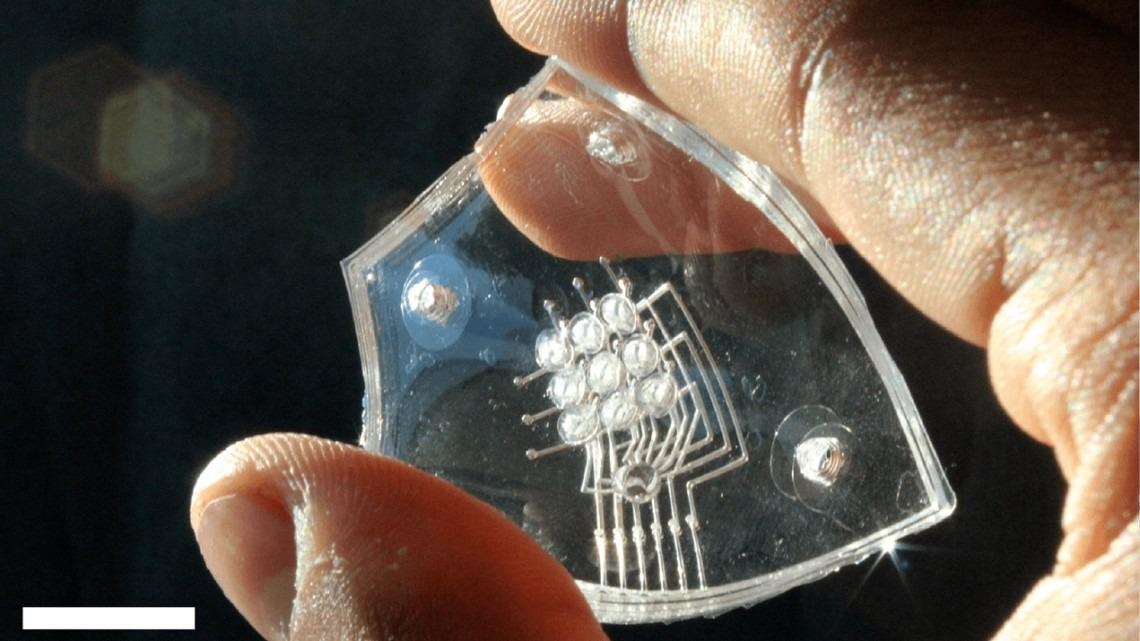A Cornell University-led collaboration has developed a critical component for a technology that enables inflatable braille that changes shape under the user’s touch. It will be like an iPad or Kindle-like tool for the blind.
 A Cornell-led collaboration created a system that uses combustion to inflate silicone membrane “dots,” which could someday serve as a dynamic braille display for electronics. The stretchable technology could also be incorporated into soft robots, surgical tools, and wearable virtual reality equipment. Image Credit: Cornell University
A Cornell-led collaboration created a system that uses combustion to inflate silicone membrane “dots,” which could someday serve as a dynamic braille display for electronics. The stretchable technology could also be incorporated into soft robots, surgical tools, and wearable virtual reality equipment. Image Credit: Cornell University
The technology is a haptic array of densely packed actuators that induces silicone membrane “dots” to pop up when triggered by combustion.
The study titled “Valveless Microliter Combustion for Densely Packed Arrays of Powerful Soft Actuators” was published in the journal Proceedings of the National Academy of Sciences, on September 28th, 2021. The study was led by a doctoral student Ronald Heisser.
One of the key challenges in developing a dynamic braille display for electronics is figuring out a technique to apply a sufficient amount of force for each dot. Earlier works have roped in motors, hydraulics or tethered pumps, all of which are inconvenient, complicated and expensive, as noted by Rob Shepherd, an associate professor of mechanical and aerospace engineering in the College of Engineering and the senior author of the paper.
Having something that can change its shape in a way you can feel, like real objects, doesn’t exist right now. There’s this tradeoff between having small actuators, and size and weight and cost. It’s so difficult. Everybody’s been trying electromechanical systems. So we said, well, what if we don’t do that at all and we use combustion. Small volumes of gas can create powerful outputs.
Rob Shepherd, Associate Professor of Mechanical and Aerospace Engineering, College of Engineering, Cornell University
The Cornell collaboration included technicians from the Israel Institute of Technology to develop a system mainly comprising molded silicone and microfluidic liquid metal traces, where liquid metal electrodes spark to ignite a microscale volume of premixed methane and oxygen.
Regarding their array design, the fuel flows through a series of independent channels, in which each channel leads to a 3-mm-wide actuator. A thin silicone membrane is forced to inflate several millimeters by the rapid combustion at each region. A magnetic latching system provides a persistent form to these dots and the entire system can be reset by simply pressing them down.
With no requirement for electromagnetic valves, the actuators can be packed densely, leading to a smaller, potentially portable system with the potential to make large displacements at high force within 1 ms. The commercial version can be safely operated due to the quick cooling capability of the fluidic elastomer actuators and the consumption of minimal fuel.
The technology is also stretchable and comfortable, and the researchers expect integration into a series of applications like soft robots and wearable reality devices that simulate artificial touch. The biocompatible components also find application in surgical tools that manipulate tissues or open blocked passageways in medical patients.
The existing system comprises nine fluidic elastomers, but the researchers believe they can scale up and make a completely electronic tactile display.
For the past 30 years or more, people have been trying to pack actuators in an array really closely together. Touch, in a way, is more intimate to us than sight. The technology has real potential. I think our work shows there’s more ways of thinking about this. Chemical actuation is really not something to be ignored.
Ronald H. Heisser, Doctoral Student, Sibley School of Mechanical and Aerospace Engineering, Cornell University
Co-authors of the study include Elizabeth Fisher, associate professor of mechanical and aerospace engineering; Perrine Pepiot, associate professor of mechanical and aerospace engineering; Sadaf Sobhani, assistant professor of mechanical and aerospace engineering; doctoral students Cameron Aubin and Nicholas Kincaid; postdoctoral researcher Hyeon Seok An; and researchers from Technion-Israel Institute of Technology.
The study was funded by the National Science Foundation, the Air Force Office of Scientific Research, and the Sloan Foundation. Most of the components were fabricated by the team at the Laboratory of Atomic and Solid State Physics (LASSP) Professional Machine Shop.
Journal Reference:
Heisser, R. H., et al. (2021) Valveless microliter combustion for densely packed arrays of powerful soft actuators. Proceedings of the National Academy of Sciences. doi.org/10.1073/pnas.2106553118.